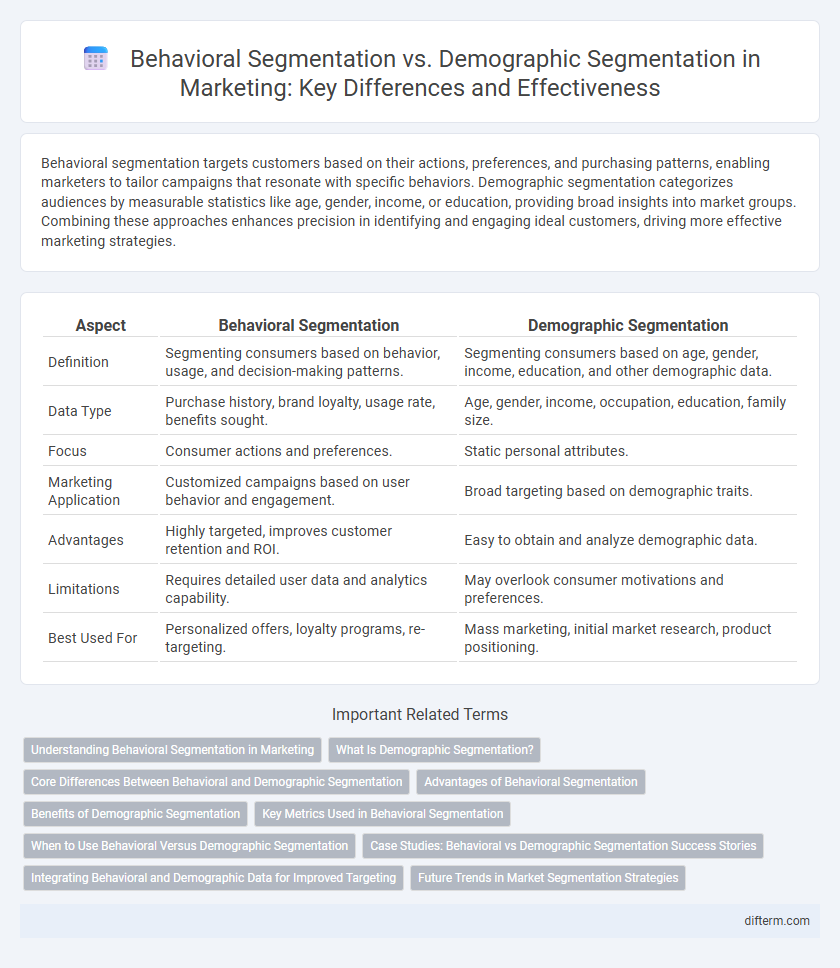Behavioral segmentation targets customers based on their actions, preferences, and purchasing patterns, enabling marketers to tailor campaigns that resonate with specific behaviors. Demographic segmentation categorizes audiences by measurable statistics like age, gender, income, or education, providing broad insights into market groups. Combining these approaches enhances precision in identifying and engaging ideal customers, driving more effective marketing strategies.
Table of Comparison
| Aspect | Behavioral Segmentation | Demographic Segmentation |
|---|---|---|
| Definition | Segmenting consumers based on behavior, usage, and decision-making patterns. | Segmenting consumers based on age, gender, income, education, and other demographic data. |
| Data Type | Purchase history, brand loyalty, usage rate, benefits sought. | Age, gender, income, occupation, education, family size. |
| Focus | Consumer actions and preferences. | Static personal attributes. |
| Marketing Application | Customized campaigns based on user behavior and engagement. | Broad targeting based on demographic traits. |
| Advantages | Highly targeted, improves customer retention and ROI. | Easy to obtain and analyze demographic data. |
| Limitations | Requires detailed user data and analytics capability. | May overlook consumer motivations and preferences. |
| Best Used For | Personalized offers, loyalty programs, re-targeting. | Mass marketing, initial market research, product positioning. |
Understanding Behavioral Segmentation in Marketing
Behavioral segmentation in marketing categorizes consumers based on their actions, such as purchasing habits, brand loyalty, and product usage frequency, enabling targeted strategies that resonate with specific customer needs. This approach contrasts with demographic segmentation, which divides audiences by age, gender, income, or education, often missing nuances in consumer behavior. Leveraging behavioral data enhances personalization, increases engagement, and drives higher conversion rates by aligning marketing efforts with actual consumer behaviors.
What Is Demographic Segmentation?
Demographic segmentation divides a market based on statistical data such as age, gender, income, education, and occupation, allowing marketers to tailor campaigns that resonate with specific population groups. This method leverages quantifiable attributes to predict consumer preferences and purchasing behaviors, ensuring targeted messaging and resource allocation. Compared to behavioral segmentation, which focuses on customer actions and decision-making patterns, demographic segmentation provides foundational insights critical for defining broad audience categories in marketing strategies.
Core Differences Between Behavioral and Demographic Segmentation
Behavioral segmentation categorizes customers based on actions such as purchase history, usage frequency, and brand loyalty, enabling marketers to tailor strategies to specific customer behaviors. Demographic segmentation divides audiences by characteristics like age, gender, income, and education, providing broad market categorization for targeting. The core difference lies in behavioral segmentation's focus on actual consumer interactions, while demographic segmentation emphasizes intrinsic personal attributes.
Advantages of Behavioral Segmentation
Behavioral segmentation offers precise targeting by analyzing customer actions such as purchase history, brand interactions, and usage frequency, leading to more personalized marketing campaigns. It enables marketers to identify high-value customers and tailor promotions that increase conversion rates and customer loyalty. Unlike demographic segmentation, it adapts dynamically to changing consumer behaviors, providing actionable insights that enhance campaign effectiveness.
Benefits of Demographic Segmentation
Demographic segmentation enables marketers to target specific age groups, income levels, and educational backgrounds, driving more personalized and relevant marketing campaigns. By leveraging demographic data, businesses can efficiently allocate resources and predict purchasing behavior with higher accuracy. This segmentation approach simplifies market analysis and enhances customer engagement through tailored messaging aligned with distinct demographic profiles.
Key Metrics Used in Behavioral Segmentation
Behavioral segmentation relies heavily on key metrics such as purchase frequency, brand loyalty, user status, and occasion-based behavior to categorize customers more precisely than demographic segmentation. This approach allows marketers to analyze consumer actions like product usage rate, engagement level, and response to marketing campaigns, resulting in highly targeted and effective marketing strategies. Metrics such as customer lifetime value and recency of purchase provide deeper insights into purchasing behavior, enabling personalized communication and optimized resource allocation.
When to Use Behavioral Versus Demographic Segmentation
Behavioral segmentation is most effective when targeting customers based on purchasing habits, brand loyalty, and product usage, enabling personalized marketing strategies that drive engagement and conversions. Demographic segmentation works best for identifying broad audience groups through age, gender, income, and education, which helps in market positioning and media planning. Choosing between behavioral and demographic segmentation depends on campaign goals, with behavioral data providing deeper insights into customer actions and demographic data offering foundational market structure.
Case Studies: Behavioral vs Demographic Segmentation Success Stories
Case studies reveal that behavioral segmentation, which targets consumer actions such as purchase history and brand loyalty, drives higher engagement and conversion rates compared to demographic segmentation based solely on age, gender, or income. For instance, Netflix's success in personalized content recommendations showcases how behavioral data improves user retention and satisfaction over traditional demographic profiling. Conversely, demographic segmentation remains effective in mass-market campaigns where broad audience categories suffice, as evidenced by Procter & Gamble's targeted advertising to age-specific groups.
Integrating Behavioral and Demographic Data for Improved Targeting
Integrating behavioral and demographic data enables marketers to create highly personalized campaigns by combining purchase patterns, online activity, age, and income. This fusion enhances targeting precision, allowing brands to tailor messages to specific consumer needs and preferences more effectively. Leveraging this combined data improves ROI by driving customer engagement through relevant offers and experiences.
Future Trends in Market Segmentation Strategies
Behavioral segmentation leverages consumer actions and purchase patterns, offering deeper insights for personalized marketing compared to demographic segmentation, which focuses on static factors like age and gender. Future trends indicate a shift towards combining behavioral data with AI-driven analytics to create dynamic, real-time customer profiles that enhance targeting accuracy. Marketers are increasingly prioritizing psychographic and behavioral variables to predict consumer needs, driving more efficient resource allocation and higher ROI.
Behavioral segmentation vs demographic segmentation Infographic

 difterm.com
difterm.com